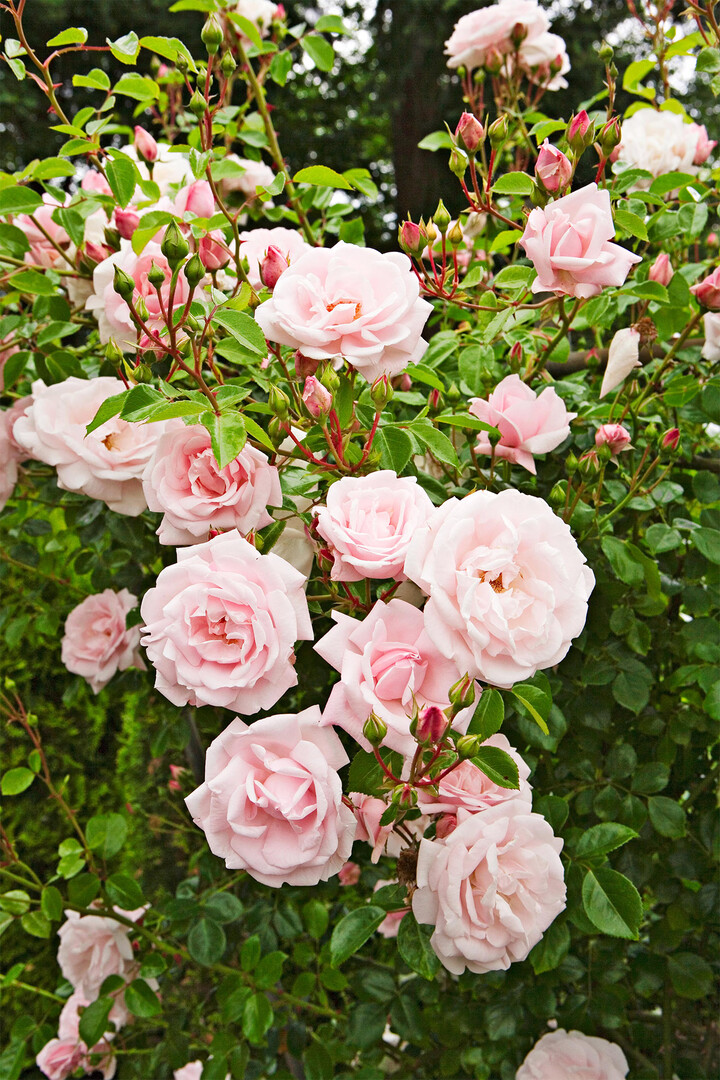Recently, we shared a photo of ‘New Dawn’ roses taken by Mariana Weber of @anatucketsummer on our Instagram account, and dozens of readers chimed in on how stunning the flowers were. “I have a New Dawn rose bush and it receives loads of compliments every year,” Charlotte McDermitt (@char3mcd) said, while other readers commented “beautiful,” “lovely,” “fairytale,” or left a few heart-eyes emojis. But some of you also asked which variety of roses they were so you could plant them in your own garden (or around your front door) this year. ‘New Dawn’ roses have been a top variety for nearly a century; they were first discovered back in 1930, and based on your reactions to Weber’s photo, their popularity has only grown with time.
At the 11th World Convention of Rose Societies in 1997, ‘New Dawn’ was voted the most popular rose in the world. It’s a climbing rose that produces huge, gorgeous light pink flowers. It can reach up to 12 feet tall and spread over six feet, and can quickly become a focal point in your garden. Like in Weber’s photo, planting ‘New Dawn’ alongside other blush pink flowers or accessories in your garden looks magical, but it also looks striking planted near flowers with darker colors, like red or hot pink roses.
How to Plant ‘New Dawn’ Rose
Most growers ship ‘New Dawn’ bareroot (dormant and without soil around the roots) in early spring. The best time to plant is in late winter or early spring, as long as you get them in the ground before it gets too warm (it's harder to establish bareroot plants once temperatures are averaging above 70°F each day). If you’re not ready to plant right when your roses arrive, keep the roots moist and leave them wrapped in plastic for a day or two.
Buy It: Rose 'New Dawn,' $29.00, White Flower Farm
Choose a spot that gets at least six hours of direct sunlight every day (though ‘New Dawn’ can tolerate part shade, you’ll get more blooms if you plant in an area with full sun). Soak the roots in a bucket of water for at least two hours before planting. Dig a hole that will give the roots plenty of room to spread out; usually about 12 to 18 inches deep, and 2 feet wide.
Mix compost into the soil at the bottom, then set the plant in the hole, spreading the roots evenly around it, and fill in with soil. The bud union (a spot that looks swollen where the base of a grafted plant meets the rootstock) should be about 1-inch above the soil. Water deeply, then add a layer of mulch on top to help hold in moisture and prevent weeds from sprouting.

‘New Dawn’ Rose Care
Part of the reason ‘New Dawn’ roses became so popular is their easy care. It needs about an inch of rain per week to thrive, so give it an extra drink during dry spells. It’s also highly resistant to diseases such as black spot, powdery mildew, and other common rose diseases. This variety is hardy in USDA Zones 5-9, and usually blooms from June through September. “New Dawn” is a repeat bloomer, so be sure to deadhead spent blooms to encourage new ones. The best time to prune is late winter; if you wait to prune until early spring, you could remove new flower buds and end up with fewer summer blooms.
How to Train ‘New Dawn’ Rose
Though it’s classified as a climbing rose, ‘New Dawn’ will need a little help scaling the side of your house or twining around a trellis. As the long canes (stems) grow, use twine to tie them to your trellis, arbor, fence, or wherever you want the roses to climb. Most other climbing vines and plants, like trumpet vine and clematis, have tendrils that they use to grip walls and trellises. Climbing roses don’t have these same tendrils, so you’ll need to keep tying the canes off to encourage them to keep climbing, but you can also grow them as a shrub without any support.